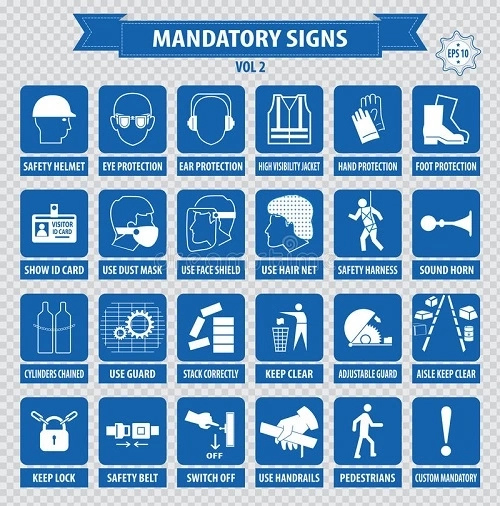Mandatory signs are safety signs used to pass information on what is required in a particular area to stay safe; it is a subset of the regulatory signs.
This sign can be used in the workplace, a domestic building, on the road, etc.
Read Also: 21 Important road signs you must understand
For example:
The picture below summarizes some very important mandatory signs. These signs come with written information or a sign that shows what is required of you at any point in time, so all you need is to look into it.

How To Identify A Mandatory Sign
There are a few indicators you can use to identify a mandatory sign, including:
Colour
Mandatory signs mostly have a blue background and tend to have a white picture within. They tell the user what to do next and are used most commonly in the workplace. Standard mandatory safety signs notify employees to wear protective footwear, helmets, or high-visibility jackets. These are most often found on construction sites. Some mandatory signs provide instructions, such as reporting to the site office.
Blue is not seen as a threatening colour, but does attract the eye. As mandatory signs have been blue since the law was set out in 1996, many people associate blue with instruction.
Design
According to Wikipedia, Mandatory signs are a subset of the regulatory sign group as defined by the United Nations Economic and Social Council in the Vienna Convention on Road Signs and Signals of 1968, and are often seen not just on their own, but used in conjunction with other signs, traffic lights and bollards as a form of visual shorthand within these objects.
In Vienna Convention signatories, the mandatory symbol is either a light blue circle with a white border (Type A) or a white circle with a red border (Type B). The sign must be at least 60 centimetres (24 in) across on rural roads, or 40 centimetres (16 in) in built-up areas, although mandatory signs incorporated in traffic lights, bollards, or larger road signs can be as little as 30 centimetres (12 in) in diameter.
The mandatory sign group is not used in Australia, Ecuador, or the United States, none of which are signatories to the Vienna Convention. Canada has developed its style using a green circle, which is not used in any other country. Below is a chart comparing some of the most common mandatory signs.
Since they generally use a white safety symbol on a blue background. This differentiates it from other signs, which may use a red background like in traffic signs/prohibition signs, and a green background like in emergency signs.
The picture above has highlighted some important mandatory signs with their meanings. So next time you step into a work premises, look out for these signs; it may be the only thing you need to guard your operations within the vicinity.
We have also given a clue on how to identify these signs – Remember, they always have a blue background.
Mandatory Road Signs
We also have the mandatory road signs; these signs are obligatory for the traffic that uses a specific area of the road. These signs indicate what one must do, rather than must not do. Mandatory Road signs are generally round with a red border. Some of them are blue. ‘Stop’ and ‘Give Way’ are octagonal and triangular, respectively, in shape. Violation of these signs attracts heavy fines and punishments. Importantly, violation of these could also lead to major accidents.
So, since mandatory signs are expected to have two (2) major colours, White and Blue, some also have red in the mix. However, do not get confused, just understand the purpose of mandatory signs, and you’re good.
When to Use Mandatory Signs
Mandatory signs spell out the actions or behaviours that are to be implemented within a workplace or area of public access to comply with relevant health and safety regulations. These actions and behaviours are considered ‘must-do’.
Mandatory safety signs, or Blue safety signs as they are often commonly known, are recognizable by a white pictogram surrounded by a blue or red background, as the case may be. These signs are to inform employees and visitors that actions must be taken to remain safe; this can include the need to utilize Personal Protective Equipment (PPE) or taking precautions to keep oneself safe in a potentially dangerous environment. They should be mounted in easily visible places for all to see clearly.
Related Articles
21 Important Safety Signs & Symbols And Their Meanings
21 Very Important Road Signs And Their Meanings
